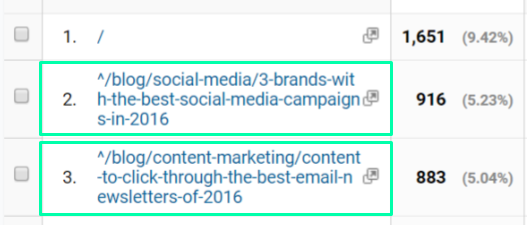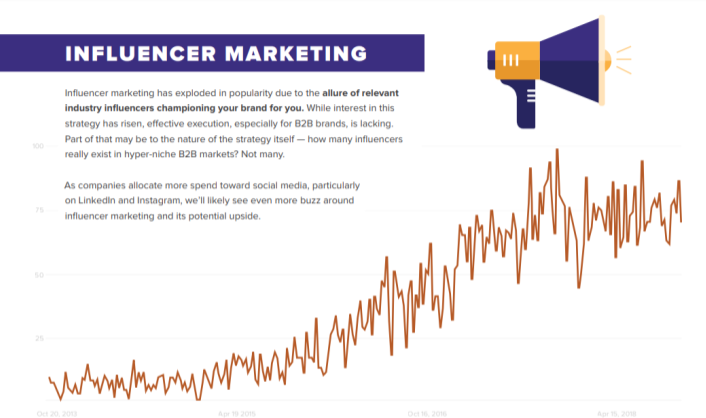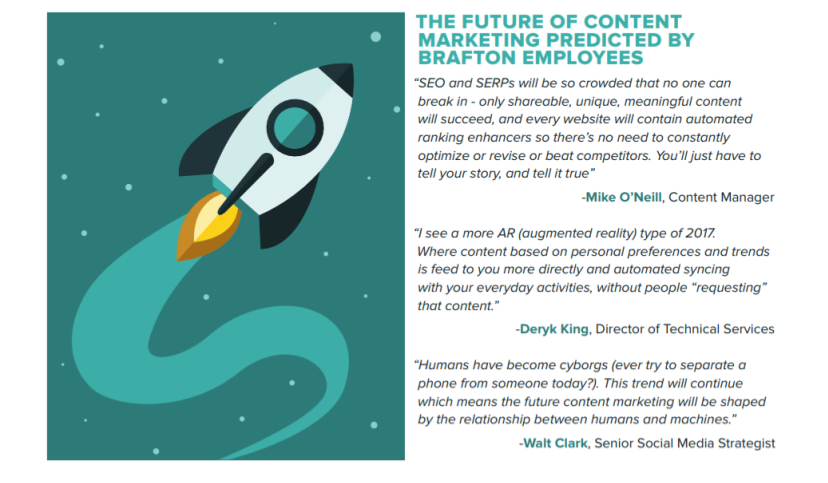Looking to expand upon your base of blog posts and the occasional infographic?
Good.
Too often, marketers start small and target only the top of the funnel. ToFu content can be easier to create and less resource-intensive relative to assets in the middle or bottom of the funnel.
But if you’re already building a content stream to keep prospects engaged, you need other formats as well – and at other points in their search journeys.
A white paper combines visual and written content with data-backed insights so leads have something more comprehensive and incisive to consume. It’s thought leadership, industry authority and relevant research all in one.
Looking for some go-to white paper examples for inspiration, here are several:
Now, let’s look at ways to generate white paper topics from scratch. That way you can differentiate your content strategy from competitors‘ and align your subject matter expertise with audience demand.
Table of Contents:
- What Is a White Paper?
- How Do White Papers Differ from Blog Posts or eBooks?
- Choosing White Paper Topics: 8 Ways
- 1. Convert an Existing Blog Post into a White Paper
- 2. Aggregate Commentary from Social Media into Perceptive Topics
- 3. Concentrate on Themes Picked up from Sales Conversations
- 4. Go Heavy on Hyper-Relevant Industry Data – and Gate It
- 5. Identify Mid-Funnel or Commercial-Intent Keywords to Build Upon
- 6. Conduct Proprietary Research, Format it and Release it
- 7. Find Where Leads Drop Off and Address that Pain Point
- 8. Complement Other Assets like Web Demos, Webinars and Tutorials
- How to Distribute and Promote Your White Paper for Max ROI

What Is a White Paper?
White papers are comprehensive, formatted assets primarily used for lead generation. They’re more data-driven and branded than blog posts but less visual than eBooks.
A white paper has no word or page count limit, although they tend to fall in the range of 1,000-10,000 words, with the goal of allowing the writer to properly explore all facets of a topic and include analysis or predictions.
Predominant white paper topics are:
- Industry trends.
- Brand solutions.
- Product or service guides.
- Data insights and observations.
- Niche, educational walk-throughs.
- Common business challenges.
White papers are typically gated, requiring readers to provide their contact information to download the document. Because they’re gated, they’re often used in email campaigns and live on distinct conversion landing pages.
How Do White Papers Differ from Blog Posts or eBooks?
So what makes a topic suited as a white paper as opposed to a blog post or eBook?
The short answer is that nearly any topic can be addressed accurately in any content format, depending on how descriptive you want to be. Then there’s the issue of how you distribute it to your audience.
If you want leads, an asset should be gated – so that removes blog posts from the equation.
If you want nuanced, detailed copy that explains a complex subject matter, a white paper is likely preferable to an eBook. eBooks often have character restrictions, as each page needs room for graphical components and various types of visualizations. A white paper, on the other hand, is copy-centric, with graphics being a supplement.
So to pick the right topics for your white paper, you’ll likely want to compile interesting, new data on that topic, gather quotes/opinions from internal/external experts and cover every subtopic related to that larger concept.
This process may take a while to develop, you could hire professional white paper design services or do it in-house whatever your choice is here’s how to get started.
Choosing White Paper Topics: 8 Ways
So to pick the right topics for your white paper, you’ll likely want to compile interesting, new data on that topic, gather quotes/opinions from internal/external experts and cover every subtopic related to that larger concept.
Here’s how to get started.

1. Convert an Existing Blog Post into a White Paper
One of the easiest and most convenient ways to write a white paper is take what already works and make it better.
Look in your Google Analytics dashboard, find your top-performing blog post of the past year and make it your next white paper.
Your blog is already relevant and well-received based on your metrics, so there’s an existing audience that can be engaged with and recaptured with an updated white paper on the same or similar topic.



For example, your blog article titled „What’s keeping HR managers up at night?“ could be converted into a white paper called „12 fears every HR manager has in 2019 and how to overcome them.“
Dive deeper, add more data and offer more solutions. That’s it.
2. Aggregate Commentary from Social Media into Perceptive Topics
Your content marketing strategy is incomplete if you’re not monitoring social media, industry forums and the comments section of other websites. The information contained in these fields comes from the type of person who is obviously engaged and wants to voice their opinion.
There’s also a lot of repetition and call-and-response going on. Comments sections are like a petri dish for future white paper topics: What are people talking about, and what do they want more of?
You can likely pull out themes from the commentary you see, like if lots of users or followers have questions on a new trend or Gallup poll.
By staying abreast of industry discussions you can uncover topics that invoke further commentary and be the first brand to tackle those ideas in full.
Comments sections are like a petri dish for future white paper topics.
It’s almost like mind reading.
3. Concentrate on Themes Picked up from Sales Conversations
Your sales department is having targeted conversations with prospects and customers every day. These calls are essentially vent sessions for pain points, common questions and pervasive curiosities.
Your sales reps can only answer so many calls and chase so many prospects. What if you could sum up all those discussions in a white paper?
You could then distribute it to prospects after the call ends so they can peruse further on their own time. You can also get out in front of inbound calls by answering as many questions as possible before the phone even rings, which qualifies your leads and increases sales potential.
Set up a weekly or monthly touch base with your sales team to better understand the themes they encounter and how you can best serve their goals through content creation.
4. Go Heavy on Hyper-Relevant Industry Data – and Gate It
The web is awash with data, but who has time to query over and over until they connect the dots on how to find and use all that disparate data?
No one.
So do it for them.
What’s a trending topic in your field right now? Artificial intelligence? GDPR?
Aggregate industry data around those topics, offer a bit of context and analysis and format it as a white paper. Now you have the most exhaustive and useful asset on the internet about that topic, and it’s highly relevant to your audience.
You can do the same thing with quotes from subject matter experts or predictions from industry analysts. Compile the work, then gate it.

5. Identify Mid-Funnel or Commercial-Intent Keywords to Build Upon
Because white papers are mid-funnel assets, it makes sense to build content around search terms that correspond to that stage of the funnel.
So instead of something like „Content marketing trends to know,“ you might aim a little lower in the funnel with „How to capitalize on the top 6 content marketing trends right now.“
The latter has urgency, requires action and is aimed at an audience persona that’s looking to fix problems, not just read general-awareness content.

In short, don’t be vague. Be as specific as possible. You’re not targeting every person under the sun; you’re writing for a decision-maker who may be close to purchasing from you.
6. Conduct Proprietary Research, Format it and Release it
Proprietary research is recognized as the top link building tactic available to marketers. The reason is simple.
You have research that no one else has. You are the sole source of information on a given topic. If someone wants that intelligence, they have to download it.
Luckily, gathering this research is easier than many think. You can do this by running a quick poll on social media and measuring the results.
Or you can ask for the opinions of your own staff – that’s data too. The more data points, the better.

We’ve taken this approach a number of times. We asked our social followers their job titles and their opinions on the future of content marketing. We got hundreds of responses, so we anthologized this data, designed it and launched it.
It was ours, and it was a simple adjunct to our marketing efforts.
7. Find Where Leads Drop Off and Address that Pain Point
The purpose of any asset is to answer questions and address pain points.
And one of the most costly business hurdles is having potential customers go silent. They either stop responding to your inquiries because they no longer have need of your services or they’ve already made up their mind to go with a different vendor. In either case, the outcome is bad for you.
Isolating that precise moment when a prospect drops off is critical to plugging the gap in your customer lifecycle marketing. Once you know what the issue is, you can then create content around it.
In some cases, that could be a white paper.
Speak with your sales team about where they’re struggling with leads and what would help them bridge the divide between potential customer and actual customer.
8. Complement Other Assets Like Web Demos, Webinars and Tutorials
White paper design supports other types of assets at other parts of the funnel.
A viewer may watch a web demo on your site and then wonder OK what now?
Or you may run a well-attended webinar but have nothing tangible to leave your listeners after the event is over.
Writing white papers to accompany adjacent marketing assets leads to a more versatile user experience. Your audience can now digest content in ways they prefer, they’re aware of next steps to be taken and they can learn about your brand on their own time
What’s not to like?
How to Distribute and Promote Your White Paper for Max Roi
White paper distribution should be a multifaceted attack. While you should have a dedicated conversion landing page where readers can download your white paper, you also have to get those readers to that page in the first place.
How do you engage middle-of-the-funnel prospects? How do you differentiate between blog topics and white paper topics? Our newest guide answers these questions and more https://t.co/r0bW9dCfLv
— Brafton (@Brafton) July 24, 2019
To do so, consider:
- Creating a clickable white paper CTA and embed it in blog posts and email newsletters.
- Sending via email to qualified leads.
- Sending via email after a relevant webinar or prospect call.
- Promoting on social media – particularly LinkedIn for B2B audiences.
- Making it the focal point of a podcast or speaking opportunity.
- Printing it out and bringing it to industry events.
- Advertising it on industry forums or via display networks.
- Using it in retargeting campaigns.
- Converting it into a viewable slideshare.
- Ungating it and releasing a teaser portion of it as a blog post or short video.
- Linking to it in press releases.
- Using it as cornerstone content and writing complementary blogs around it to send more traffic its way.
Final Words on White Papers
White papers empower your brand to flex its industry credentials. You’re not just another logo in your niche; you’re a thought leader and a content leader.
While we don’t like to get bogged down in semantics, consider the differences between white papers and eBooks before embarking on the content creation process, as mentioned before. eBooks are much more visual and can be horizontally formatted. White papers, however, are more dense, data-driven and text-based. As you can guess, your white paper topic (or eBook topic) should ideally fall into either camp — not both. Trust us; it will make your graphic designer’s life much easier.
Though white papers are conventionally thought of as B2B marketing assets, there’s room for B2C versions as well. These are typically in the form of product guides and expanded FAQ documents. A good white paper ultimately provides rich insight into the topic; if your target audience prefers one format over the other, that’s fine.
Because the demand for high-quality information on new ideas is ever-present, the white paper remains a foundational content type that all marketers should explore. Now if you could only nail down a specific topic to get you started…






